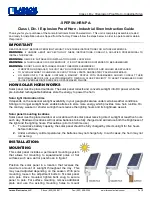
manual
11
victron energy
1.6 Turning the inverter on
When all the above requirements are checked and satisfied and all
connections are made, it’s time to turn on your Phoenix inverter by
pushing the power switch to the '
I
' position (see top label for push
direction). After a short two tone beep (except Phxx/220 models),
indicating that all internal circuits are checked, the sinewave shaped
output voltage gently rises until 230V/50Hz
±
2% is reached.
When the inverter is not supplying power to an appliance for a longer
time, it’s recommended to use the inverter in the "economy" mode to
heavily reduce the inverter's own power consumption. In this case the
power switch must be pushed in the '
II
' position. In the economy mode
the inverter will generate a testpulse on it's output once per second, to
check that there is a load applied. When the economy mode is activated
(by generating a reversed two tone beep, except Phxx/220 models), the
indicator LED will be continuously on for 4 seconds while the inverter
outputs a continuous 230V (or 115V) sinewave. After this 4 seconds the
continuous output will change to a pulsed output, indicated by a
flashing indicator LED. When a load is connected to the inverter output
(or switched on) drawing more than approx. 12W (or 15W depending
on model), the inverter jumps to the continuous mode immediately,
delivering power to the load. When the load is disconnected again (or
switched off), the indicator LED starts flashing again after 4 seconds,
and the inverter jumps back to the pulsed output economy mode. This
way the inverter automatically jumps to a low power 'sleep' mode when
there is no power demand on the output.
Note that some loads like TV/video equipment (with standby mode) and
alarm clocks need continuous power so that the economy mode can not
be used.
With some small non compensated loads, it is possible that the inverter
jumps from continuous output to pulsed output and vice versa all the
time. In this case you have to connect a small additional load to the AC
output.












































